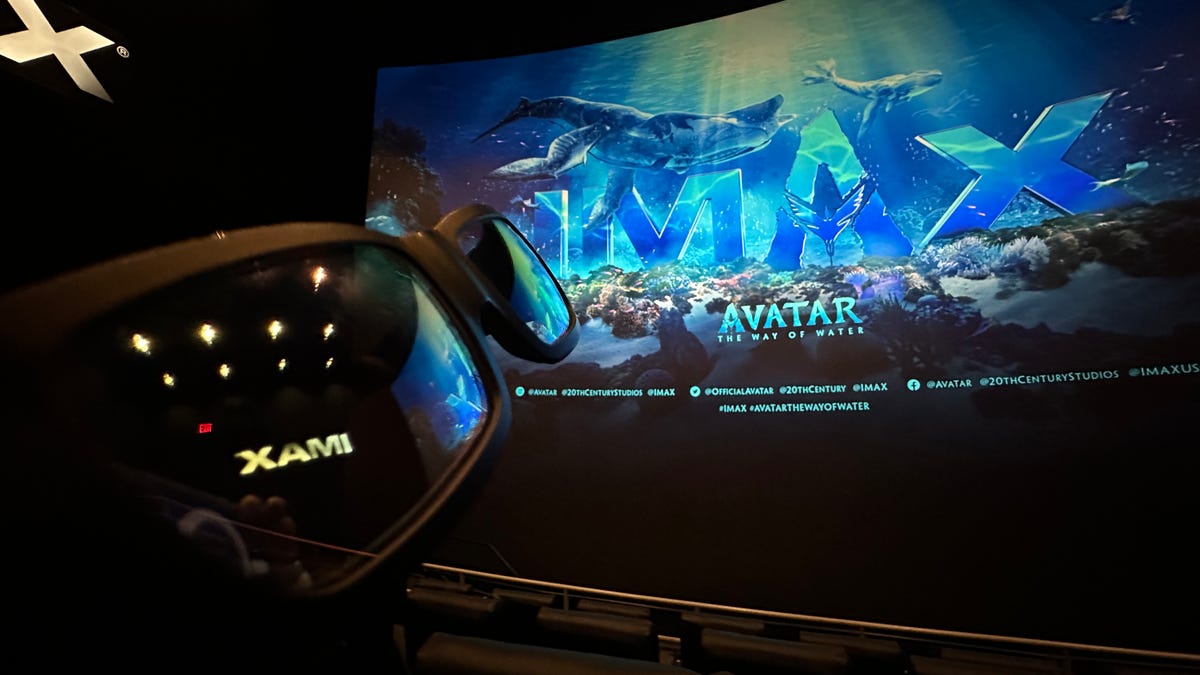 Why You Can Trust CNET
Why You Can Trust CNET 'Avatar: The Way of Water' Is the First Film I'd Want to Watch in a VR Headset
In Imax 3D, it was utterly hyperreal.

My first 3D IMAX film in a while was worth the experience.
There was a moment, sometime in the first hour of watching James Cameron's newest film, Avatar: The Way of Water, that I turned my head to the side. I don't know what I was doing. I think I was trying to look around the room I was in, a cavern the Na'vi were hiding in. I thought I'd see the other details. I was in a movie theater, of course. A towering Imax screen in front of me, 3D glasses on. This has never happened to me before.
I guess there are those stories of early film, people who'd scream at the oncoming train, thinking it was real. I think I found myself, in moments of Way of Water, losing myself in its reality. My mind began to tap into 3D experiences I often have -- not In film, but in VR.
I saw the original Avatar in Imax 3D way back in 2009. It was astonishing then, but in my memory more as a vast canvas, a world I could peer into. The Way of Water felt, somehow, more… immersive? I felt I was moving through it. I sat next to my colleague, David Katzmaier, at a screening on New York City's towering AMC Lincoln Square Imax screen. He's an incredibly seasoned display expert who's hard to impress. I think he felt the same. He equated it to being on a Disney ride, which I still haven't experienced.
I haven't thought about 3D films since maybe 2013, and I don't even know if The Way of Water makes me believe more in the power of 3D films, either. Instead, I had this sensation of something different, some sort of hyperreal 3D experience that was more reminiscent of virtual VR worlds and even video games. This isn't an insult to James Cameron at all; it's just that the smooth, ultra-real 3D this movie ended up becoming in Imax
I remember moments like these in terms of landscapes, as if I could look around.
Video games on high-end consoles and PCs often have that moment where you think you're watching a cinematic cutscene, and then suddenly you realize you're able to control your character in a shockingly realistic world. I felt, at times, moments away from that feeling in The Way of Water, especially since many of its most memorable moments were directed in fluid shots and perspectives that seemed to follow characters as they moved, or even looked directly at characters through the perspective of another's eyes.
This is intentional, I think. It becomes particularly powerful later on, in the film's shocking aquatic scenes. At the higher frame rate of the screening, these moments resembled nature documentaries and made me feel even more convinced that what I was seeing was somehow actually real. It made the emotional impact greater (I don't want to share spoilers regarding what I'm referring to).
Earlier on, in the first hour, the detail, fluid movement, and intensely rich 3D graphics were a bit jarring, even uncanny. I have to admit I felt like I'd started watching cutscenes from a video game on a 2027-era PlayStation. I had to remind myself that this was a film.
Weirdly, 3D on a massive Imax screen helps make experiences more intimate (for me). I kept taking off my glasses and becoming more aware of the screen's sheer scale. With glasses on, my field of view framed perfectly to the scope of the screen, I found the experience more focused. Almost like looking into a VR headset.
Of course, there are no VR headsets that have the resolution and fidelity of what I saw in Imax. Most VR headsets aren't even good enough for movie-watching rivaling your TV or iPad. But technology's getting better. The ultra-high-res Varjo XR-3 VR headset is the closest I've seen to "retina" level VR. If headsets from Apple and others up the bar for visuals and audio, maybe we'll inch closer still.
James Cameron has worked with AR devices like the Microsoft HoloLens in real life for oceanographic research projects, and the new Avatar film, like the original, is full of scenes where holographic arrays float in front of characters. My entire viewing of The Way of Water felt in a sense like a holographic experience. It was like a prototype vision of something VR can't yet achieve.
But I also thought about something else The Way of Water achieved. Watching a trailer at home the next day, I remember moments I'd seen in 3D as if they were something real I had witnessed. Or a live theatrical performance, maybe. The original Avatar was about people who moved between bodies, a form of telepresence into the real world. William Gibson explores this idea in his book and recent Amazon series, The Peripheral, to a different end. The Way of Water didn't have characters moving back and forth between bodies nearly as much: the world they occupied, and the bodies they inhabited, for the most part, were the same. Their reality was locked in.
Instead, I felt like the avatar. For a few hours, I was in their world. For all of the rich 3D worlds Cameron has clearly made, I'd be curious how I could visit it again. Not just in future films, but in VR headsets to come.

